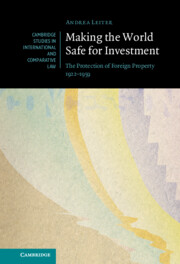Book contents
- Making the World Safe for Investment
- Cambridge Studies in International and Comparative Law: 178
- Making the World Safe for Investment
- Copyright page
- Dedication
- Contents
- Preface and Acknowledgments
- Prologue
- 1 Making the World Safe for Investment
- 2 The Palestine Railway Arbitration 1922
- 3 The Lena Goldfields Arbitration 1930
- 4 The Sheikh of Abu Dhabi Arbitration 1951
- 5 The Abs–Shawcross Draft Convention 1959
- 6 Conclusions
- Bibliography
- Index
- Cambridge Studies in International and Comparative Law: 178
1 - Making the World Safe for Investment
Published online by Cambridge University Press: 23 February 2023
- Making the World Safe for Investment
- Cambridge Studies in International and Comparative Law: 178
- Making the World Safe for Investment
- Copyright page
- Dedication
- Contents
- Preface and Acknowledgments
- Prologue
- 1 Making the World Safe for Investment
- 2 The Palestine Railway Arbitration 1922
- 3 The Lena Goldfields Arbitration 1930
- 4 The Sheikh of Abu Dhabi Arbitration 1951
- 5 The Abs–Shawcross Draft Convention 1959
- 6 Conclusions
- Bibliography
- Index
- Cambridge Studies in International and Comparative Law: 178
Summary
This chapter outlines the framework and argumentative structure of the book. It introduces the assertion of jurisdictional authority over concession agreements, which is the key site of the analysis. While concession agreements in the 1920s were considered exclusively a matter of domestic law, in the 1950s a powerful community of scholars and practitioners argued that they should fall under an international legal order and be called ‘economic development agreements’. This internationalisation was a claim for the universality of ideas propagating private property and the sanctity of contract, as well as a rejection of the authority of socialist and anti-colonial policies to redistributive ends. Western industry, former imperial governments and liberal thinkers of law and of economics successfully claimed the international sphere for building a new legal order. The authority for such an international legal regime was based on a temporalisation of difference that relied on concepts like ‘civilisation’ and development to downgrade challenges to the rules of property protection by locating such challenges in the past. This was a process of self-authorisation through legal practice and academic writing, laying the groundwork for the later emergence of the regime of international investment law.
Keywords
- Type
- Chapter
- Information
- Making the World Safe for InvestmentThe Protection of Foreign Property 1922–1959, pp. 1 - 26Publisher: Cambridge University PressPrint publication year: 2023



